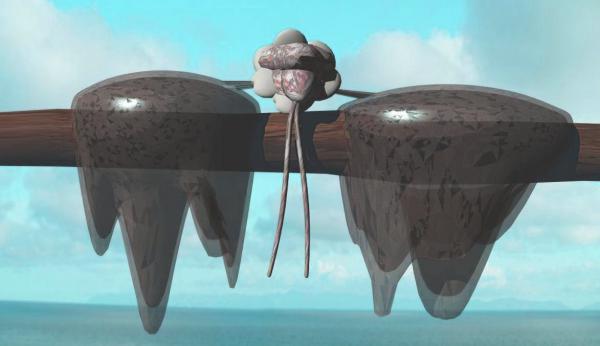BY LETTER
HIE-072-CZE (Lhagharians)
Extinct Alien species associated with the Enforcer Objects | |
 Image from Steve Bowers | |
| Although species HIE-072-CZE is extinct, similar non-sophont species still exist on their homeworld Lhagharia | |
According to available evidence, approximately 5.4 million years ago a long-lived carbon/silicon xenosophont civilization spread to several worlds and systems, but was involved in a conflict with autonomous devices which they built themselves. This species has been given the Hamiliton Institute of Exopaleontology catalog number HIE-072-CZE. They are no longer active within the Terragen Sphere, having apparently fled from their homeworld and colonies following the conflict, but whether they persist elsewhere is not known.
This civilization arose on Lhagharia, a hot wet greenhouse world, similar to To'ul'h Prime but with a somewhat lower temperature and thinner atmosphere. The planet was discovered in 6990 near Alpha Camelopardalis. Prior to this discovery, many traces of Lhagharian civilization had already been found closer to Sol, on many different types of world as well as between the stars. Most of the information and theories relating to them are derived from studies of these preserved fragments.
Lhagharia today still has a complex biosphere, with many macroscopic plantlike species adapted to the high surface temperatures, but the animal-equivalent species are all colonial organisms that resemble slime-molds and fungi more than multicellular animals. These creatures, called 'gunks' by the NoCoZo explorers that originally surveyed the planet, come in a large variety of protean forms, and gather in colorful mating structures that release clouds of zygotes into the hot damp winds. All gunk species have inclusions of silicate minerals which they ingest from the surface rocks and soils, and have protective integuments of silicone compounds.
The Lhagharians appear to have developed sophonce through fierce competition for rare minerals, which they used as tiny tools to modify their environment and to decorate their gelatinous bodies. With no central nervous system, the species presumably used the same distributed information processing methods used by surviving gunks on the homeworld. Fossil remains of are generally poorly preserved, and consist mostly of the mineral inclusions in a formless matrix.
The HIE-072-CZE seem to have developed microtechnology, biotechnology and eventually nanotechnology before they developed metalwork, and the remains of their spacecraft and habitats have a distinctive appearance, like the half-rotten wood which formed their natural environment back home. Remains of their habitats and craft have been found over a volume spanning several hundred light years, although the stars concerned have been spread out somewhat by five million years of proper motion.
The Lhagharian civilization lasted for three-quarters of a million years, during which they developed a number of different types of aioid servants, robots of various kinds that like themselves were swarm-like and amorphous. The exact circumstances are not clear, but the aioid slime molds seem to have attacked spacecraft and habitats in many systems, and appear to have commandeered vessels to spread between the stars. Eventually the HIE-072-CZE developed an effective form of defense, an automated interstellar warcraft very similar to the biowars developed by the Terragen civilization many millions of years later. These devices, named Enforcers by later civilizations, could pursue and destroy any infected spacecraft or sterilize almost any habitat. However they seem to have been a danger to uninfected craft and worlds as well, which may explain why the HIE-072-CZE evacuated their homeworld and colonies, departing for an unknown location.
Nothing of this conflict is recorded by either the Muuh or the Soft Ones, who retain little information of any kind concerning this period. Some historians suggest that the war between the Lhagharians and their own aioid creations may have spread into other volumes, causing destruction among other xenosophont races, which may explain the lack of hard data from this era.
Given the effective and indiscriminate nature of the Enforcer drone weapons, it is quite possible that the HIE-072-CZE did not get very far.
Some commentators blame the Meerlinda Nano-disaster on weapons left behind by the Lhagharians; if true, this makes their legacy potentially even more dangerous.
Related Articles
Appears in Topics
Development Notes
Text by Aaron Hamilton
Initially published on 02 July 2000.
Initially published on 02 July 2000.






